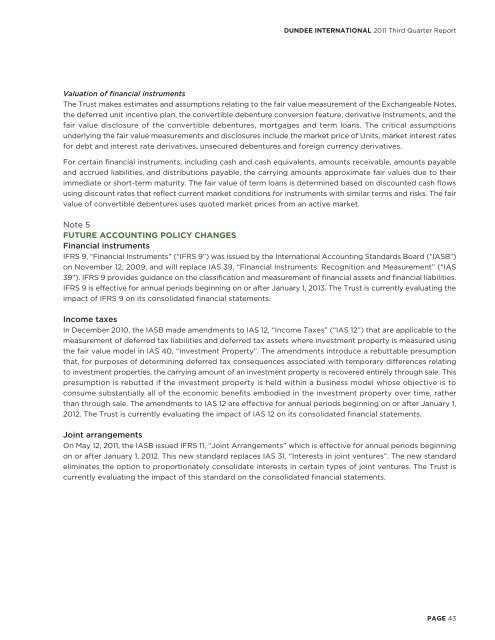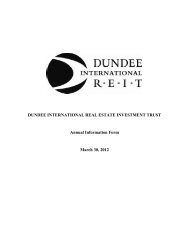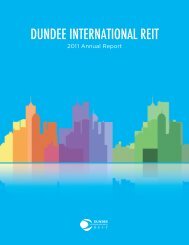DUNDEE INTERNATIONAL REIT
DUNDEE INTERNATIONAL REIT
DUNDEE INTERNATIONAL REIT
Create successful ePaper yourself
Turn your PDF publications into a flip-book with our unique Google optimized e-Paper software.
<strong>DUNDEE</strong> <strong>INTERNATIONAL</strong> 2011 Third Quarter Report<br />
Valuation of financial instruments<br />
The Trust makes estimates and assumptions relating to the fair value measurement of the Exchangeable Notes,<br />
the deferred unit incentive plan, the convertible debenture conversion feature, derivative instruments, and the<br />
fair value disclosure of the convertible debentures, mortgages and term loans. The critical assumptions<br />
underlying the fair value measurements and disclosures include the market price of Units, market interest rates<br />
for debt and interest rate derivatives, unsecured debentures and foreign currency derivatives.<br />
For certain financial instruments, including cash and cash equivalents, amounts receivable, amounts payable<br />
and accrued liabilities, and distributions payable, the carrying amounts approximate fair values due to their<br />
immediate or short-term maturity. The fair value of term loans is determined based on discounted cash flows<br />
using discount rates that reflect current market conditions for instruments with similar terms and risks. The fair<br />
value of convertible debentures uses quoted market prices from an active market.<br />
Note 5<br />
FUTURE ACCOUNTING POLICY CHANGES<br />
Financial instruments<br />
IFRS 9, “Financial Instruments” (“IFRS 9”) was issued by the International Accounting Standards Board (“IASB”)<br />
on November 12, 2009, and will replace IAS 39, “Financial Instruments: Recognition and Measurement” (“IAS<br />
39”). IFRS 9 provides guidance on the classification and measurement of financial assets and financial liabilities.<br />
IFRS 9 is effective for annual periods beginning on or after January 1, 2013. The Trust is currently evaluating the<br />
impact of IFRS 9 on its consolidated financial statements.<br />
Income taxes<br />
In December 2010, the IASB made amendments to IAS 12, “Income Taxes” (“IAS 12”) that are applicable to the<br />
measurement of deferred tax liabilities and deferred tax assets where investment property is measured using<br />
the fair value model in IAS 40, “Investment Property”. The amendments introduce a rebuttable presumption<br />
that, for purposes of determining deferred tax consequences associated with temporary differences relating<br />
to investment properties, the carrying amount of an investment property is recovered entirely through sale. This<br />
presumption is rebutted if the investment property is held within a business model whose objective is to<br />
consume substantially all of the economic benefits embodied in the investment property over time, rather<br />
than through sale. The amendments to IAS 12 are effective for annual periods beginning on or after January 1,<br />
2012. The Trust is currently evaluating the impact of IAS 12 on its consolidated financial statements.<br />
Joint arrangements<br />
On May 12, 2011, the IASB issued IFRS 11, “Joint Arrangements” which is effective for annual periods beginning<br />
on or after January 1, 2012. This new standard replaces IAS 31, “Interests in joint ventures”. The new standard<br />
eliminates the option to proportionately consolidate interests in certain types of joint ventures. The Trust is<br />
currently evaluating the impact of this standard on the consolidated financial statements.<br />
PAGE 43






